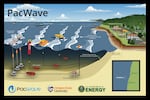UPDATE (May 6 at 11:25 a.m. PT) — An innovative wave-energy project proposed for Oregon has entered a key stretch as it seeks the environmental approvals needed to move forward.
Oregon State University’s PacWave testing array would be located about 7 miles offshore. An underwater cable would connect the array to the electrical grid just north of Waldport on the state's central coast.

Permitting is underway for a new wave energy test facility off Oregon's coast.
USDOE
The project is designed to help facilitate the development of technology that generates electricity using the movement of waves. The idea is to create a space for wave energy developers to test their designs in real-world conditions without having to go through individual environmental permitting processes, which take significant time and money.
The Oregon Department of Environmental Quality is holding a public teleconference hearing on May 14 to address water quality concerns arising form the project.
The Federal Energy Regulatory Commission released the draft environmental assessment for the project in late April, finding that the project would not significantly impact environmental quality.
Earlier in the permitting process, the Oregon Department of Fish and Wildlife had requested that FERC require changes to the project to protect wildlife habitat on land and the ocean floor.
ODFW asked for additional measures to protect the snowy plover, a threatened shorebird that nests on Oregon's beaches.
In addition, ODFW asked that project managers avoid all rocky ocean bottom when laying the underwater power cable to “maximize burial depth.” The agency commented that the structures that would be needed to secure an unburied cable “could increase scour effects on seafloor habitat and introduce ecological and fishing hazards.”
Federal regulators declined to include either of ODFW's requests in the draft Environmental Assessment, finding of the ocean bottom concerns that “OSU has done everything technically and financially feasible to bury the cable, and it appears complete burial cannot be practically achieved.”
ODFW declined to be interviewed for this story.
“I think FERC did a good job of balancing both OSU’s perspective and the needs of the project, [while] also accommodating some of the comments that came in from the resource agencies,” PacWave project manager Justin Klure said.
Klure said the current trajectory of permitting could allow construction to begin in late summer of this year, with the undersea cable being installed in 2022.
Eventually, four different wave energy technologies could be tested at once at PacWave, with the project providing monitoring equipment to determine how well each design works.
But PacWave’s ultimate success will depend on wave-energy developers contracting with OSU to use the test facility.
“That pipeline of testing clients is critical to the overall program,” Klure said, adding that U.S. Department of Energy has recently granted funds to four companies to design wave-energy devices that would be eligible to test at PacWave.
“There has been quite a bit of traction made now in trying to start to fill that pipeline for potential developers.”
Correction: May 6, 2020. An earlier version of this story misstated the proposed location of Oregon State University’s PacWave testing array. It would be located about 7 miles offshore.
